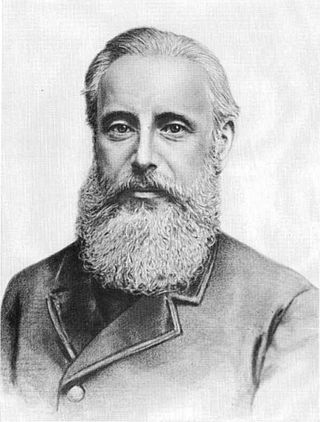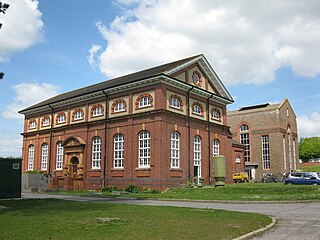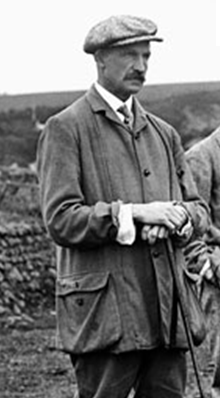
The River Brede is an English river in East Sussex. It flows into the Rock Channel and then onto the River Rother at Rye, Sussex. It takes its name from the village of Brede, which lies between Hastings and Tenterden.

Henry Rossiter Worthington was an American mechanical engineer, inventor, industrialist and founder of the American Society of Mechanical Engineers in 1880.

Brede is a village and civil parish in the Rother district of East Sussex, England. It is located eight miles (13 km) north of Hastings and four miles (6 km) west of Rye.
The Weir Group plc is a Scottish multinational engineering company headquartered in Glasgow, Scotland. It is listed on the London Stock Exchange and is a constituent of the FTSE 100 Index.

Bristol Water is a British water company which supplies 266 million litres of drinking water daily to over 1.2 million customers in a 2,600 km2 (1,000 sq mi) area centred on Bristol, England. It is regulated under the Water Industry Act 1991. Sewerage services in the Bristol area are provided by Wessex Water.

The Kempton Park steam engines are two large triple-expansion steam engines, dating from 1926–1929, at the Kempton Park Waterworks in south-west London. They were ordered by the Metropolitan Water Board and manufactured by Worthington-Simpson in Newark-On-Trent.

London Museum of Water & Steam is an independent museum founded in 1975 as the Kew Bridge Steam Museum. It was rebranded in early 2014 following a major investment project.

The Flowserve Corporation is an American multinational corporation and one of the largest suppliers of industrial and environmental machinery such as pumps, valves, end face mechanical seals, automation, and services to the power, oil, gas, chemical and other industries. Headquartered in Irving, Texas, which is in the Dallas–Fort Worth Metroplex, Flowserve employs close to 16,000 employees in more than 50 countries. Flowserve sells products and offers aftermarket services to engineering and construction firms, original equipment manufacturers, distributors, and end users. The Flowserve brand name originated in 1997 with a merger of BW/IP and Durco International.

Charles Campbell Worthington, or C.C. Worthington, was an American industrialist whose efforts were in part responsible for the foundation of the Professional Golfers Association. He invented the first commercially successful gang lawnmower for fairway maintenance.

Grosvenor Canal was a canal in the Pimlico area of London, opened in 1824. It was progressively shortened, as first the railways to Victoria Station and then the Ebury Bridge housing estate were built over it. It remained in use until 1995, enabling barges to be loaded with refuse for removal from the city, making it the last canal in London to operate commercially. A small part of it remains within the Grosvenor Waterside development.

Mount Crosby pumping station is a heritage-listed pumping station and weir at Stumers Road, Mount Crosby, City of Brisbane, Queensland, Australia. It is located on the Brisbane River and extends into Chuwar on the other side of the river. The facility supplies water to Brisbane and nearby cities and towns within the SEQ Water Grid. It was originally designed by Charles H McLay and built from 1891 to 1892. The historic parts of the facility were added to the Queensland Heritage Register on 25 October 2019. It is also listed on the Brisbane Heritage Register, together with numerous associated facilities which were not included in the state heritage listing.

James Simpson (1799–1869) was a British civil engineer. He was president of the Institution of Civil Engineers from January 1853 to January 1855.

Kempton Park Reservoirs are a Site of Special Scientific Interest in the London Borough of Hounslow and Kempton Park in Surrey. It is owned by Thames Water. It is part of South West London Waterbodies Ramsar site and Special Protection Area Kempton Park East reservoir is also a local nature reserve.

Brede Waterworks is a waterworks at Brede, East Sussex, England. It was built to supply Hastings with drinking water. The waterworks still houses two of the three stationary steam engines that were used to pump water from Brede to reservoirs at Fairlight and Baldslow.

The City of Nottingham Water Department (1912–1974), formerly the Nottingham Corporation Water Department (1880–1912), was responsible for the supply of water to Nottingham from 1880 to 1974. The first water supply company in the town was the Nottingham Waterworks Company, established in 1696, which took water from the River Leen, and later from springs at Scotholme, when the river became polluted. Other companies were set up in the late 18th century and in 1824, while in 1826 the Trent Water Company was established. They employed Thomas Hawksley as their engineer, who became one of the great water engineers of the period, and Nottingham had the first constant pressurised water supply system in the country. The various companies amalgamated in 1845, and Hawksley remained as the consulting engineer until 1879.
Dresser-Rand is an American engineering and manufacturing company owned by Siemens Energy. The company designs, manufactures, and services equipment used in the extraction of petroleum and natural gas. The company was formed in 1986 as a joint venture of Dresser Industries and Ingersoll Rand.
Thomas Simpson (1755–1823) was a British civil engineer.
Studebaker-Worthington was a diversified American manufacturer created in 1967 through a merger of Studebaker Corporation, Wagner Electric and Worthington Corporation. The company was in turn acquired by McGraw-Edison in 1979.

The Worthington Corporation was a diversified American manufacturer that had its roots in Worthington and Baker, a steam pump manufacturer founded in 1845. In 1967 it merged with Studebaker and Wagner Electric to form Studebaker-Worthington. This company was in turn acquired by McGraw-Edison in 1979.

Derald H. Ruttenberg was a lawyer who became a deal maker, organizing large industrial mergers. He arranged the merger of Studebaker and Worthington Corporation, and for some time ran the combined Studebaker-Worthington. He provided the financing for the Derald H. Ruttenberg Cancer Center at Mount Sinai Hospital, New York.




















